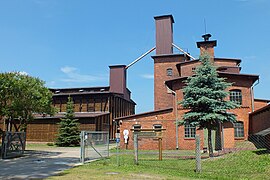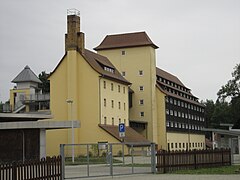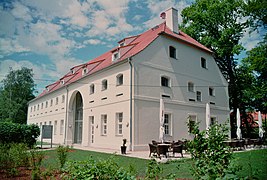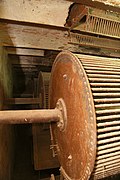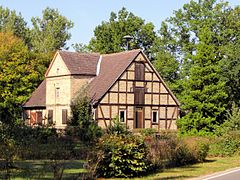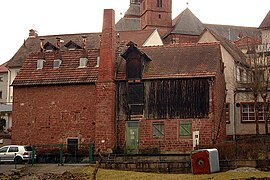Forest seed kiln
A Forstsamendarre even Samenklenge or Klenge called, is a forestry device for seed supply. The company processes the seeds of deciduous and coniferous trees, but also of bushes, into forest seeds .
Tasks of a seed cycle
In the mostly state-run companies, seeds from bushes and trees are harvested, dried, deflated, cleaned, stored and sold. They ensure proven, high-quality propagation material. In order to cover the need for afforestation , but also for the sowing of new plantings, this “artificial” extraction must be used. The marketing of forest seeds and seedlings is subject to since 1 January 2003 Forstvermehrungsgutgesetz . Only approved crops that meet certain criteria such as good wood properties, straight growth or resistance to pests may be harvested.
harvest
The work in the kiln is seasonal. In Central European latitudes, cones are treated first after the Douglas firs have been harvested. After the Douglas fir, the cones or fruits of the pines, spruces , beeches , oaks and alders are harvested, as well as rose hips and mulberries or from rarer tree species such as fir species and service berries .
Trained tree climbers win the seeds by climbing standing trees and picking the cones. Cones that have fallen on the ground cannot be used: they are mature and their seeds have already been dispersed by the wind. Until the 1960s, this activity was carried out by day laborers, who often worked in the trees without safety devices. Since then, the crampon technique has mainly been used, and tree-friendly methods such as abseiling have now become established. The tree climbers pick the unopened fruit clusters from the trees, which are then dried. For example, cones from conifers are harvested green and immature and ripen under controlled conditions.
Technique of Semen Collection
Auscyclegen is understood as semening in general, be it through heat or mechanical aids. Darren is the seeding of the cones using heat. The actual drying process takes place through heating in special ovens. Darren is now a computer-controlled processing process that is based on decades of experience of those working in this branch. The cones are heated and dried on trays for three days at a constantly controlled temperature of approx. 40 to 50 ° C (depending on the type of cones). As a result of the heating, the now opened seeds can be separated from their shells using a vibrating sieve. This technique was developed in the middle of the 14th century by the Nuremberg councilor and merchant Peter Stromer . The seeds can be stored in cold stores for up to 25 years. The remaining cones are used for decorative or heating purposes. The name Kleng comes from the sound of spruce or pine cones popping open when they release the seeds . The following example makes the seed yield clear: 16 kg of seeds are obtained from one ton of pines .
Dissemination and takers
There are eight forest seed kilns in Germany, for example the Jatznick forest seed kiln or the Saxony-Anhalt state kiln in Annaburg. Tree nurseries (in particular forest tree nurseries ), garden centers or forestry offices are buyers of seed cycles ; the seed cycle itself is not responsible for the production of seedlings. One kilogram of certified quality spruce seeds, from which around 50,000 seedlings can be grown, currently costs up to 400 euros. In addition to harvesting seeds, Seed Cycles usually also offer guided tours for groups and school classes.
literature
- H. Künzel: Germany's large industrial workshops - The Griesheimer Klenger . In: The Gazebo . Issue 9, 1867, pp. 132-135 ( full text [ Wikisource ]).
- The nursery of the Bavarian economic forest . In: Chiemgau-Blätter , February 5, 2005
- dpa: Mixed harvest year for tree seeds. In: Frankfurter Rundschau . October 20, 2008, p. R7 , accessed October 21, 2008 .
Web links
- Catalog of links on the topic of seed cycles / forest seed trees at curlie.org (formerly DMOZ )
- Peter Münch: Oaks pave their way . Spiegel Online , March 29, 2005

